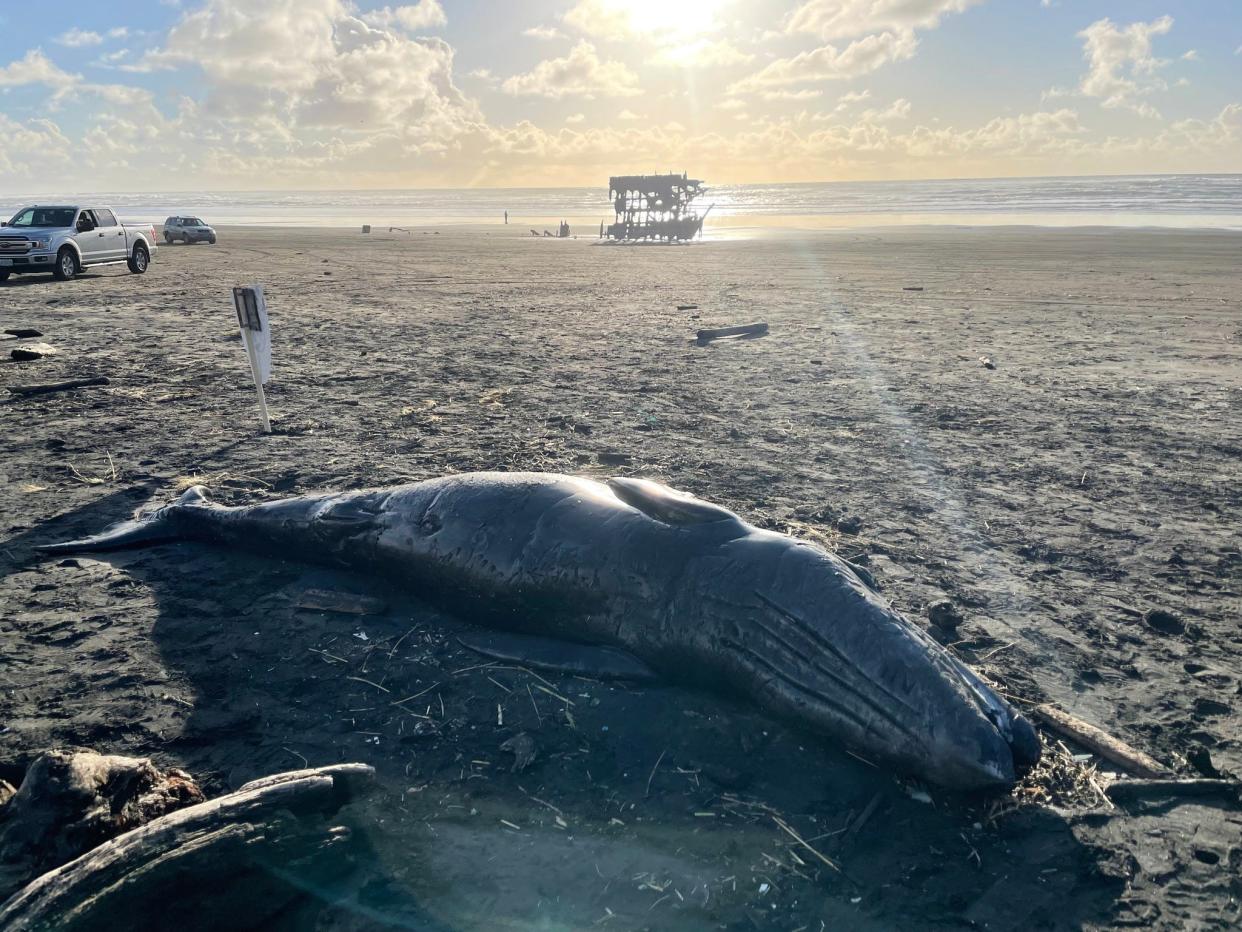Second whale washes ashore at Fort Stevens, third to die on Oregon Coast this month

A second dead whale has washed ashore on the Oregon Coast near the Peter Iredale wreck near Fort Stevens State Park. But it's actually the third whale to wash ashore on the Oregon Coast this month, amid concerns over the declining numbers of gray while in particular.
The most recent death is a baby gray whale that is roughly 12 feet in length, Seaside Aquarium said in a news release, that washed ashore on Wednesday. In this case, the whale died before it arrived on the beach but there are "no indications that this whale was struck by a ship or died from human interaction," aquarium officials said.
The previous whale, a 40-foot sperm whale, washed in over the weekend and officials determined that it died after being struck and killed by a ship, according to a necropsy conducted by the National Oceanic and Atmospheric Administration.
A third whale washed ashore near Winchester Bay on Jan. 11. It was a subadult male gray whale that appeared to have been preyed upon by killer whales, according to a necropsy, said Michael Milstein with NOAA Fisheries.
On average, about six whales are found dead, or strand, on Oregon Coast beaches each year, Milstein said. Seven whales washed ashore in 2022 and 2021, while six stranded in 2020. (See bottom of the page for whale death statistics going back to 2015).
Currently around 25,000 gray whales are migrating past Oregon and down to their birthing and breeding grounds near Baja, before returning to better ground for feeding in the north Pacific around spring break.
Explore Oregon Podcast: How whale moms protect their calves, plus Oregon's wildest waterfall
"Right now we're at the peak of southbound migration, so this is the time we tend to see this happening," Milstein said. "I wouldn't say this is particularly unusual, it just happened to take place at one of the most visited beaches in Oregon."
That said, Milstein noted there is reason to be concerned about gray whale numbers overall. Gray whale numbers have been declining and the number of new calves being born "has been very low," he said. There is concern warming in Arctic waters, where gray whales feed, is causing an impact in the population.
"They haven't been replacing themselves, and there is definitely something going on with gray whales, which is something we're investigating," he said.
What caused baby whale's death?
A necropsy is scheduled to take place on the baby whale that washed ashore at Fort Stevens on Friday.
Seaside Aquarium offered an initial assessment: "Most likely, this is a case of failure to thrive. However, until a necropsy is performed, we will not know for sure. A necropsy will be scheduled soon."
Milstein said the whale was so small it was likely a stillborn or died shortly after being born. Some baby whales are born during the migrations. And necropsy could add to the information about why calf numbers have been low.
The Oregon Parks and Recreation Department planned to move the carcass of the first whale a few miles up the beach, close to the Columbia River jetty, "in order to allow it to decompose naturally while giving birds and animals a chance to get nutrients," Oregon Parks and Recreation Department spokeswoman Stefanie Knowlton said. "Eventually, the carcass will be buried if needed."
Knowlton said the agency would likely take similar action with the baby whale, to "move the carcass if needed and then allow it to decompose in place," she said Thursday morning.
There are no plans to use dynamite to disperse either of the whale's carcasses, as the state infamously did in 1970.
Whales that "strand" on the Oregon Coast (die and wash up)
2015: 4
Blue whale: 1
Gray whale: 1
Humpback whale: 1
Stejneger's beaked whale: 1
2016: 8
Gray whale: 4
Humpback whale: 3
Pygmy sperm whale: 1
2017: 9
Gray whale: 5
Killer whale: 1
Pygmy sperm whale: 1
Sperm whale: 2
2018: 2
gray whale: 1
sperm whale: 1
2019: 10
Gray whale: 8
Humpback whale: 1
Pygmy sperm whale: 1
2020: 6
Gray whale: 3
Humpback whale: 1
Sei whale: 1
Sperm whale: 1
2021: 7
Gray whale: 3
Humpback whale: 2
Sperm whale: 2
2022: 7
Gray whale: 4
Killer whale: 1
Sperm whale: 2
Data: Oregon Marine Mammal Stranding Network.
Zach Urness has been an outdoors reporter in Oregon for 15 years and is host of the Explore Oregon Podcast. To support his work, subscribe to the Statesman Journal. Urness is the author of “Best Hikes with Kids: Oregon” and “Hiking Southern Oregon.” He can be reached at zurness@StatesmanJournal.com or (503) 399-6801. Find him on Twitter at @ZachsORoutdoors.
This article originally appeared on Salem Statesman Journal: Second whale washes ashore at Fort Stevens, third to die on coast

